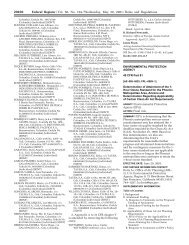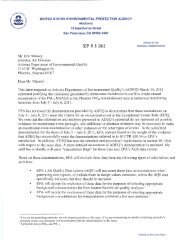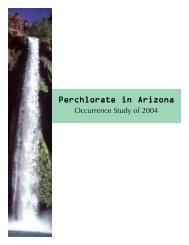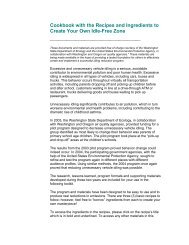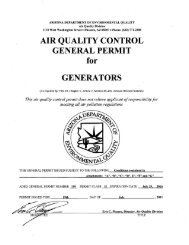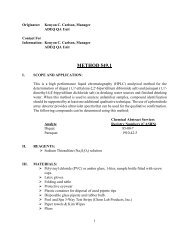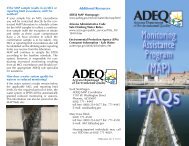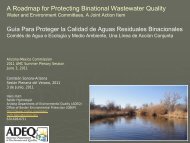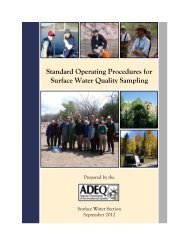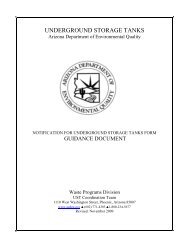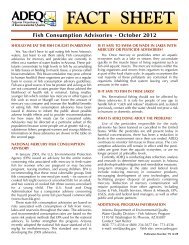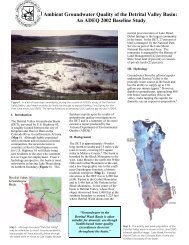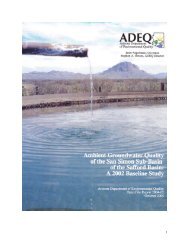AMC Environmental and Water Committees Action Item - Arizona ...
AMC Environmental and Water Committees Action Item - Arizona ...
AMC Environmental and Water Committees Action Item - Arizona ...
You also want an ePaper? Increase the reach of your titles
YUMPU automatically turns print PDFs into web optimized ePapers that Google loves.
ARIZONA-MEXICO COMMISSIONENVIRONMENT COMMITTEE AND WATER COMMITTEEDECEMBER 2009 JOINT ACTION ITEMFINAL REPORTPrepared by Hans Huth<strong>Arizona</strong> Department of <strong>Environmental</strong> Quality (ADEQ)Office of Border <strong>Environmental</strong> Protection (OBEP)In coordination withQ.B. Veronica MeranzaNogales, Sonora Municipal Pretreatment Program AdministratorNogales, Sonora <strong>Water</strong> <strong>and</strong> Wastewater Utility (OOMAPAS-NS)Presented: June 3, 2011
direct engagement of the regulated community regarding the binational significance ofwastewater pollution; providing resources <strong>and</strong> training to the Nogales, Sonora PretreatmentProgram for monitoring <strong>and</strong> water quality analyses; <strong>and</strong> holding quarterly meetings with bothregulators <strong>and</strong> the regulated community regarding the quality of influent sourced to Sonora.The U.S. <strong>and</strong> Mexico Sections of IBWC must fund, implement <strong>and</strong> maintain an effectivepretreatment program to ensure short-term successes realized continue <strong>and</strong> that discharges fromthe NIWTP do not adversely impact the Santa Cruz River.3
ACTION ITEM PROGRESS – TACTIC ACADMIUM SOURCES IN AMBOS NOGALES WASTEWATERThe Nogales Pretreatment Program is an important component for protecting the quality ofwastewater treated <strong>and</strong> discharged by the NIWTP. OOMAPAS-NS is required to submit anannual report on pretreatment to the U.S. <strong>Environmental</strong> Protection Agency (EPA) as acontingency for receipt of Border Environment Infrastructure Funds (BEIF). The most recentpretreatment report was submitted to EPA on July 23, 2010 for calendar year 2009.Given its superior anti-corrosive <strong>and</strong> pigmentation properties, cadmium is used in a variety ofindustrial processes. Based on a review of the OOMAPAS-NS 2009 pretreatment database,potential sources of cadmium were flagged. Within the 135 permitted facilities identified, 64were identified as potentially having cadmium on site. Of these, 37 use water in their processing.Of these, four have historically discharged cadmium in wastewater, <strong>and</strong> two at levels aboveMexico’s own regulatory limits. Industrial processes outlined in the Nogales, Sonora,pretreatment database are somewhat vague, so facilities <strong>and</strong> sites may be incorrectly classified assource areas with numbers biased on the high end.ADEQ has exported the Nogales, Sonora pretreatment database to a geographic informationsystem (GIS). Maps generated from the GIS show the geographic distribution of historicalsources of cadmium based on available data. Most of these facilities are operating in the southernhalf of the basin <strong>and</strong> are expected to have their wastewater treated in Sonora once the Los AlisosWastewater Treatment Plant comes online, anticipated to be in the first quarter of 2012. In thiscontext, mitigation of cadmium sources carries added binational interest. Figure 1 was created insupport of the <strong>AMC</strong> <strong>Action</strong> <strong>Item</strong> (Tactic A) focused on developing a qualitative characterizationof cadmium sources.The Nogales, <strong>Arizona</strong>, Pretreatment Program is another important component for protecting thequality of wastewater treated <strong>and</strong> discharged by the NIWTP. The city’s responsibilities includecollector monitoring for source characterization of any contamination that may be impacting theNIWTP. The city is working with ADEQ to perform an industrial source characterization at thistime. In the interim, Figure 2 is based on a field survey conducted by ADEQ in December 2010for the primary industrial/commercial area in Nogales, <strong>Arizona</strong>. The preliminary survey suggeststhat although Nogales, <strong>Arizona</strong>, is less important as a source of metals in binational wastewater,it does host facilities that may impact wastewater quality.5
ACTION ITEM PROGRESS – TACTIC BWASTEWATER COLLECTOR MONITORING IN NOGALES, SONORAOOMAPAS-NS notes that it may not have records of all potential industrial or commercialsources that may be impacting wastewater in Nogales, Sonora. Some facilities are hidden fromview <strong>and</strong>/or have not filed appropriate paperwork with the municipality. In this context, Tactic Bof the <strong>Action</strong> <strong>Item</strong> was adopted with the goal of better characterizing respective sources.Although the State of Sonora <strong>Water</strong> Commission (CEA) is identified as a responsible party forexecution, CEA must rely on OOMAPAS-NS for monitoring in the conveyance. To address this,a letter was forwarded from CEA to OOMAPAS-NS recognizing adoption of the <strong>Action</strong> <strong>Item</strong><strong>and</strong> soliciting support for its completion. A copy of the letter is included as Attachment A.At the December 2009 <strong>AMC</strong> plenary meeting, IBWC committed $60,000 to support respectivemonitoring activities. IBWC’s monetary commitment decreased to $1,800 by the end of its fiscalyear. IBWC’s revised commitment would support the collection of 60 samples to be analyzed forcadmium, chromium, <strong>and</strong> zinc as opposed to a more comprehensive characterization of thewastewater collection system if they to had met their original commitment. In response,OOMAPAS-NS planned to have two autosamplers collecting 24-hour composites for 30 daysdownstream of two important industrial sites. The monitoring was originally scheduled to takeplace October 14 through November 10, 2010 to coincide with IBWC’s monitoring of theInternational Outfall Interceptor (IOI). In doing so, any contamination associated with a specificindustrial site could potentially be linked to detection in the IOI. The locations selected byOOMAPAS-NS for monitoring are summarized in Table 1 <strong>and</strong> shown in Figure 3.Table 1. Manholes Selected by OOMAPAS-NS for Wastewater Collector MonitoringCollector GPS X GPS Y Elevation (m)Colinas del Yaqui 505297 3459164 1264Tecnologico 505258 3463789 1205In support of this activity, ADEQ coordinated with the City of Phoenix Pretreatment Program insecuring two rehabilitated autosamplers <strong>and</strong> two HACH spectrophotometers for wastewatermonitoring <strong>and</strong> analysis. ADEQ also assisted in the development of a sample plan <strong>and</strong> deliveryof samples to an <strong>Arizona</strong> laboratory for analyses. ADEQ was also on site in Nogales, Sonora, toprovide technical support on an as-needed basis. Copies of letters of appreciation from themunicipality to the City of Phoenix <strong>and</strong> the HACH Company are included as Attachment B.Respective monitoring was initiated in Nogales, Sonora, on October 18, 2010 <strong>and</strong> concluded onNovember 2, 2010. Wastewater quality analyses for cadmium, chromium <strong>and</strong> zinc were receivedfrom IBWC on December 6, 2010. Twenty-four hour composite samples associated with theColinas del Yaqui collector showed detections of cadmium ranging from 1 to 10 parts permillion <strong>and</strong> at levels up to 10 times the Mexican federal st<strong>and</strong>ard for an industrial point discharge(ECO-1996-NOM-002). Photos associated with the sampling activities are presented asAttachment C.8
On January 25, 2011, ADEQ received quarterly monitoring data for wastewater quality in theIOI. The IBWC reported a spike in cadmium loadings on October 26, 2010 at the border withMexico (0.0587 parts per million). This correlates with a spike in cadmium detected in theColinas del Yaqui collector during the same time period (9.91 parts per million). The spike at theborder translates to a total loading of 2.07 kg of cadmium entering from Sonora on October 26,2011. This is significantly higher than the total influent allowable head works loadings (AHL)for the Nogales International Wastewater Treatment Plant (NIWTP). The overall AHL forcadmium is 0.19 kg/day. That level is set for the protection of the plant’s biosolids.Results from this monitoring demonstrate that facilities discharging to the Colinas del Yaquicollector are an important source of cadmium in binational wastewater. Consequently,OOMAPAS-NS has conducted regular inspections <strong>and</strong> enforcement actions of upstream sources.9
Sewage from Nogales, <strong>Arizona</strong> <strong>and</strong> Nogales, Sonora Exceeding the Capacities Allotted to theUnited States <strong>and</strong> Mexico Under Minute Number 227.Table 2. IBWC AZPDES Monitoring Results for Total Cadmium at Manhole 1; August 2009 – October 2010.Month Average DailyLoading (kg/day)Total MonthlyLoading (kg)August 2009 2.65 76.76October 2009 2.25 67.60January 2010 1.14 34.08April 2010 0.99 29.82August 2010 0.06 1.93October 2010 0.28 8.38An important factor for maintaining wastewater quality is the Nogales, Sonora, municipalpretreatment program, which falls under the jurisdiction of OOMAPAS-NS. CILA doescommunicate IBWC’s concerns regarding the quality of binational wastewater to OOMAPAS-NS. It does not, however, provide the municipality with technical, personnel, or material supportto address these issues. Nogales, Sonora, faces tremendous challenges related to overtaxedwastewater infrastructure, severe monsoonal flooding, <strong>and</strong> providing potable water to a growingresidential <strong>and</strong> industrial footprint. In this context, concerns communicated by IBWC throughCILA must compete with other priorities. Expecting the municipality to address a federalwastewater quality issue in the absence of support from IBWC or CILA is challenging.Over the last five years, various U.S. stakeholders have supported OOMAPAS-NS in thedevelopment of its program. Contributing stakeholders include the City of Phoenix PretreatmentProgram, EPA’s Border 2012 <strong>Environmental</strong> Program, ADEQ’s Office of Border <strong>Environmental</strong>Protection (OBEP), FOSCR, private corporations including ISCO <strong>and</strong> HACH, <strong>and</strong> volunteers.Coordinating these stakeholders has taken place through OBEP. OOMAPAS-NS has respondedby pursuing modifications to Sonora state laws under its authority to strengthen the municipalpretreatment program, <strong>and</strong> investing in a water quality laboratory for wastewater analyses.Continuation of these efforts by IBWC to ensure sustainability of past successes is vital for theprotection of the NIWTP <strong>and</strong> the Santa Cruz River. For the benefit of IBWC <strong>and</strong> CILA,strategies for metals mitigation in binational wastewater are outlined here based on the successesrealized in 2010.‣ Ensuring there is direct engagement of the regulated community regarding the binationalsignificance of wastewater pollution.‣ Providing resources, training, <strong>and</strong> technical support to the Nogales, Sonora, MunicipalPretreatment Program for monitoring <strong>and</strong> water quality analyses.‣ Participating in regular meetings with both regulators <strong>and</strong> the regulated communityregarding the quality of influent sourced to Sonora.With respect to engaging the regulated community, two main organizations that OOMAPAS-NS<strong>and</strong> ADEQ have received support from in terms of relaying information to their members are theSonora Association of Maquiladoras (Asociacion de Maquiladoras de Sonora) <strong>and</strong> theAssociation of <strong>Environmental</strong> Safety Professionals of Sonora (Asociacion de Profesionales en12
Seguridad Ambiental). Additionally, there are organizations <strong>and</strong> individuals that have supportedefforts associated with this action item. The points of contact for these organizations are noted inthe tables below.Table 3. Industry Organizations in Nogales, Sonora to Engage in Binational <strong>Water</strong> Quality IssuesContact Organization Email PhoneIng. Jesus Montoya, Associacion de Maquiladoras de direccion@amsnogales.com.mx (631) 314-0111Executive Director Sonora (AMS)(631) 341-0112Nelly FuentesCurrent PresidentAssociacion de Professionales deSeguridad Ambiental (APSA)Nelly.Fuentes@mtdproducts.com (631) 314-2991Table 4. Contacts that can Facilitate Purchase <strong>and</strong>/or Donations of EquipmentContact Organization Email PhoneIng. Roberto MolinaBorder AffairsCoordinatorComisión Estatal del Agua(CEA)Q.B. Veronica MeranzaNogales, SonoraPretreatmentAdministrator <strong>and</strong>recipient of donationsRoger Vail,Senior PretreatmentInspectorDennis <strong>and</strong> Amy GamacheSarajane Gr<strong>and</strong>iaHACH DonationsCommitteeOrganismo Operador deAgua Potable,Alcantarillado ySaneamiento de Nogales,Sonora (OOMAPAS-NS)City of Phoenix MunicipalPretreatment Programvirreyes3@hotmail.com 011-52-662-289-5700ext.105veronica.meranza@oomapasnogales.gob.mx011-52-631-314-7272roger.vail@phoenix.gov (602) 534-2920Western <strong>Environmental</strong>Equipment Companyargamache@weeci.com (480) 607-2884Hach Love Foundation donations@hach.com Coordinatecommunications throughRoger Vail.Additional details regarding contacts, equipment needs, engagement of the Sonora stakeholders,<strong>and</strong>/or recommendations summarized in this report are available upon request.13
Attachment A:Letter from CEA to OOMAPAS-NS recognizing adoption of the<strong>Action</strong> <strong>Item</strong> <strong>and</strong> soliciting support for its completion.14
Attachment B:Letters of appreciation from the Municipality of Nogales, Sonorato City of Phoenix <strong>and</strong> the HACH Company for equipment support.16
Attachment C:Photos associated with sampling activities in Nogales, Sonora.19
Photos Demonstrating Collection of Wastewater Sampling in Nogales, SonoraPhoto 1: OOMAPAS-NS pretreatment van at the manholeidentified as Colinas del Yaqui. This location is downstream of ahistorical source of cadmium.Photo 2: This is a SIGMA-900 autosampler that has been modified to fit inthe smaller diameter manholes commonly associated with wastewatercollectors in Nogales, Sonora. The pump <strong>and</strong> CPU have been removed fromthe original sampler housing <strong>and</strong> are bolted to a plywood board. The boardis suspended from an iron cross anchored at the top of the manhole.A composite sample bottle is suspended from the plywood backing throughthe use of cables <strong>and</strong> hooks. To facilitate continuous monitoring, a singlecomposite bottle is lined with ISCO ProPak disposable polyethylene bags,<strong>and</strong> pre-preserved with 25 ml of undiluted nitric acid. The bottle is suspendedfrom a hook on the plywood backing.Photo 3: This image shows the outfall for the Colinas del Yaquicollector within the manhole. This configuration is typical of mostmanholes in Nogales, Sonora. For this reason, composite samplesare time-weighted rather than flow-weighted.OOMAPAS-NS saves on battery costs through the purchase of st<strong>and</strong>ard 12Vmarine batteries that are inserted in original equipment Sigma housing. Thehousing is then duct-taped shut <strong>and</strong> attached to the plywood backing.20
Photos Demonstrating Collection of Wastewater Sampling in Nogales, SonoraPhoto 5: Over time, fatigueassociated with the intaketubing resulted in samplesbeing missed. In this photo,OOMAPAS-NS is using ducttape to compensate fortubing fatigue. An ISCO GLScompact autosampler wouldresolve this issue.Photo 4: This show the modified autosampler installation in themanhole. The autosampler is covered in a garbage bag to preventdamage from humidity. The sample bottle is suspended from theplywood backing.Photo 6: This shows the extraction of the autosamplerafter a 24-hour composite. Samples are typicallycomposited at a rate of 100 ml every 20 minutes. As perthe sample plan, the composited sample will be tested forpH. If necessary, additional acid will be added to thesample to bring its pH down to 2. OOMAPAS-NS will alsocollect a grab sample for field parameter testing.21
Photos Demonstrating Collection of Wastewater Sampling in Nogales, SonoraPhoto 7: This is the site associated with El Tecnologico Wash. As a resultof a faulty sensor, the modified Sigma autosampler would not calibrate forcollection of a 100 ml sample. OOMAPAS-NS replaced the Sigma withone of its two compact autosamplers. OOMAPAS-NS operates its entireoversight monitoring program with only two compact autosamplers.Additional rehabilitated autosamplers were provided to OOMAPAS-NS bythe City of Phoenix, but were too large to work with the smaller manholesin Nogales. As such, they are currently on loan to colleagues supportingthe Agua Prieta Municipal Pretreatment Program in Sonora. Agua Prieta islocated just south of Douglas, <strong>Arizona</strong>.Photo 8: Since OOMAPAS-NS is not using an original equipment batterypack, the sampler housing will not close properly. The autosampler is sealedwith duct-tape to protect its CPU from damage caused by humidity.Photo 9: This is the OOMAPAS-NS water quality laboratory. Thisfacility was constructed to house a flame atomic absorptionspectrophotometer shown under the L-shaped metal vent. This unitwas purchased through an EPA Border 2012 grant. OOMAPAS-NSmore than doubled EPA’s investment through the construction of thewater quality laboratory.22
Attachment DADEQ Engagement of Sonoran Stakeholders in Support of the <strong>AMC</strong> <strong>Action</strong> <strong>Item</strong>23
ADEQ Engagement of Sonora Stakeholders in Support of the <strong>AMC</strong> <strong>Action</strong> <strong>Item</strong>November 2009 – December 2010Date Entity Forum Scope11/25/2009 Association of <strong>Environmental</strong>Safety Engineers (APSA)Monthly Meeting Regulated community briefed onwastewater quality challenges.12/4/2009 <strong>Arizona</strong>-Mexico Commission(<strong>AMC</strong>)December Plenary <strong>Action</strong> item on source characterization<strong>and</strong> mitigation of metals in wastewateris developed.2/10/2010 Nogales, Sonora Public Works Interagency Meeting Briefing on <strong>AMC</strong> action item.Department (OOMAPAS-NS)2/10/2010 APSA Monthly Meeting Regulated community engaged onaction item <strong>and</strong> asked for assistancewith source characterization.3/3/2010 Association of Maquiladoras ofSonora (AMS)Board of Directors Plant managers briefed on wastewaterquality challenges <strong>and</strong> goals of <strong>AMC</strong>action item.4/30/2010 OOMAPAS-NS Interagency Meeting Progress report on <strong>AMC</strong> action item is6/10/2010 City of Phoenix Pollution ControlDivision6/25/2010 State of Sonora <strong>Water</strong>Commission (CEA)Interagency MeetingInteragency Meetingprepared.Summarized equipment limitation ofthe Nogales, Sonora PretreatmentProgram.CEA requested progress report on<strong>AMC</strong> action item <strong>and</strong> offers support asneeded.6/30/2010 OOMAPAS-NS Interagency Meeting Updated progress report on <strong>AMC</strong>action item, <strong>and</strong> compiled list ofequipment needs for pretreatmentmonitoring.6/30/3010 APSA Monthly Meeting Regulated community updated on<strong>AMC</strong> action item progress.8/18/2010 OOMAPAS-NS Interagency Meeting Discussed source characterization <strong>and</strong>regulatory actions.9/23/2010 APSA Annual Meeting Regulated community briefed onwastewater quality challenges <strong>and</strong>progress related to <strong>AMC</strong> action item.12/10/2010 AMS Board of Directors Plant managers briefed on progressassociated with <strong>AMC</strong> action item.24



